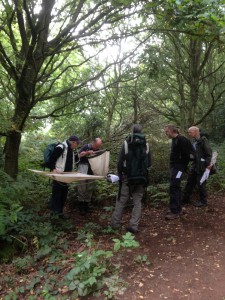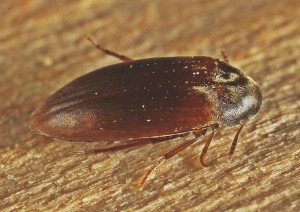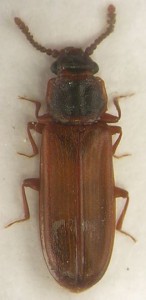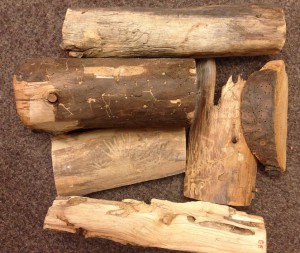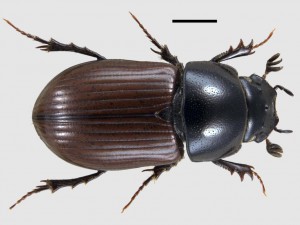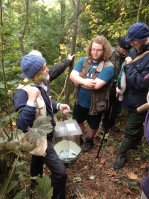
Three words that sum up recent weeks and more so than ever! I have worked with Liam Olds quite a bit in the last couple of months and it’s been great to jointly share our new found skills and strengths with the wider world. As Liam has told you all about the TCV training day at Dare Valley, Invertebrate Link Symposium 2015 and the visit to the Forest of Dean, I will not add more here but please do have a peak at his wonderful blog.
Liam also came along on the inaugural meeting of the British Entomological and Natural History Society (BENHS) new special interest group on saproxylic insects. This event took place on 20th September at Shotover Country Park on the outskirts of Oxford. This was a well-supported field meeting with around 25 people attending. The local community group Shotover Wildlife have been studying the site since 1999 and have already identified around 150 species each of saproxylic Coleoptera and Diptera.
The first find of the day was Eulagius filicornis, a naturalised recent arrival in this country, which was found in good numbers on aerial dead branches of oak trees showing fresh growth of the fungus Stereum hirsutum. Two Nationally Scarce beetles were found: Phloiophilus edwardsii and Orchesia minor along with the Red Data Book species Synchita separanda. This beetle is most often found on Beech trees where they feed on sappy bark and wood or on Sycamore in dark brown powdery smut-like fungus under thin bark. Orchesia minor develops in the fruiting body of a variety of polypore (bracket) fungi and is usually associated with areas of ancient woodland or wood pasture.
Another old woodland indicator species, Pediacus dermestoides was also discovered at the Shotover site. This interesting little beetle is dorsoventrally flattened making it look as if it has been gently squashed by an overzealous child. It is a great strategy when pushing yourself underneath even the tightest fitting bark. The adults are fungivorous but the larvae are predatory on other insects and both life stages can be found on pine and broadleaf trees. To read a fuller account of the day’s activities, please check out the new and developing Saproxylics UK website.
The end of September and into October, found me north of the border on a trip up to the Orkneys. Unfortunately I didn’t manage to catch up with Susan Miller as she had already left, heading south, but instead I enjoyed a wonderful holiday catching up with family friends and hunting for dung beetles.
My feet didn’t touch the ground for long once back in Oxford as it was off to Bangor and Anglesey with Darren Mann. The primary mission of this trip was to retrieve a collection of insect damaged wood that had been generously donated to the museum from the Gwynedd Museum and Art Gallery. The damaged wood collection comprised of around a dozen boxes of assorted pieces of wood. This wood is currently undergoing the quarantine process for pest control – a good practice that is put into place in museums to ensure that unwanted pests are not inadvertently imported into collections when new material arrives. It essentially involves items being sealed inside heavy duty plastic and a stint of at least 2 weeks in the -20˚C freezer. The rate at which the desired temperature is reached is important here too and generally the faster the better and ideally within four hours. After the allotted time, items are removed with wrappings in place until they have thoroughly defrosted. This is to ensure that any condensed moisture generated by the change in temperature doesn’t come into contact with the specimens and have potentially damaging results.
I am eagerly anticipating the day when the donated collection comes out of the freezer and with the supplied inventory in hand, I will be as happy as a bark beetle!
We also managed a little time on the sand dunes looking for, yep you guessed it – dung beetles. Permanently grazed dune systems are pretty scarce in terms of habitat availability but are great places to look for dung beetles. I saw two species that I had not, so far, come across. These were Aphodius conspurcatus and Aphodius lapponum. The latter was found high up in the mountainous region of Snowdonia on the return journey. Scotland is the stronghold for A. lapponum as it prefers cooler temperatures. The larvae have a lower, upper limit of thermal tolerance than many Aphodius dung beetles and die if they become too hot. These beetles occur as far south as the Brecon Beacons but are absent from central and southern England.
January 2016 and the end of the traineeship seems to be coming aorund all too quickly. It has been a fantastic year so far, I have learnt SO MUCH. Thank you TCV and Esmee Fairbairn Foundation, its not over yet but already I can say the scheme really has helped mould me into a functioning entomologist.
Also, good luck to all those who have secured interviews for the Traineeships beginning next year.

